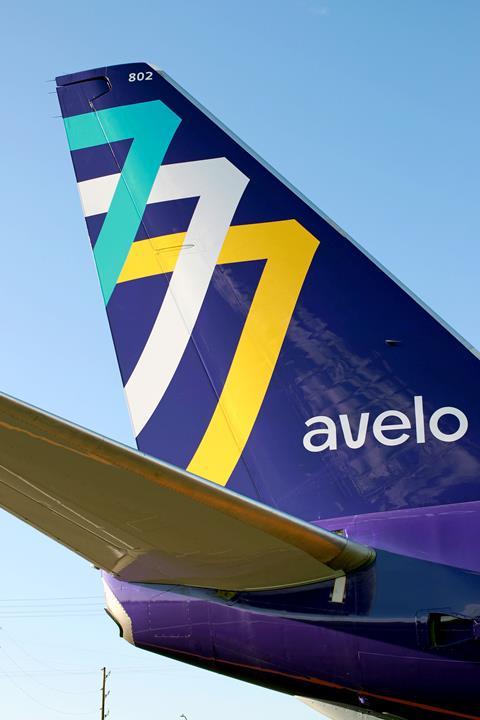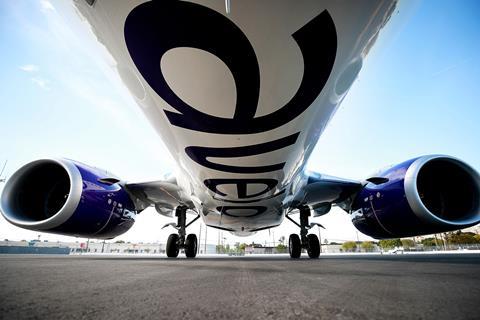Three years have passed since US start-up Avelo Airlines first took off from Burbank, California with an aggressive plan to carve a niche among established ultra-low-cost carriers (ULCCs).
Avelo started with three mid-life Boeing 737NGs and a network covering a handful of routes out of Burbank. It now flies to 51 cities with a 16-strong fleet of 737s, jockeying for position alongside fellow start-up Breeze Airways as well as Allegiant Air, Frontier Airlines, JetBlue Airways, Spirit Airlines and Sun Country Airlines.
“We’ve come a long way,” Trevor Yealy, Avelo’s director of commercial, told FlightGlobal this month. “It’s been a pretty neat ride to see the airline develop, and of course we’re still in the early innings of growth and maturity.”
The company turned its first-ever profit during the final three months of last year – a milestone that Avelo’s leadership would have liked to have celebrated sooner.
“It took us longer than we anticipated,” Yealy acknowledges. “But we came out of an environment that was highly uncertain, starting in the throes of the pandemic in April 2021. Nobody knew what the demand environment was going to look like.”
Indeed, the start-up has navigated variants of Covid-19, surging jet fuel prices due to Russia’s war in Ukraine and various “demand shocks” to transportation systems, Yealy says, while still managing to establish nine operational bases across the USA.
With Breeze also recently reporting its first full-month profit, both upstart ULCCs are seemingly overcoming odds in a challenging operating environment.

Avelo’s strength is its strategy of flying its 737s to overlooked cities and secondary airports near major metropolitan areas. The airline has made a habit of identifying airports it believes are underused by other airlines, yet within proximity to large populations.
And it all started in Southern California.
“Burbank is an awesome secondary airport of the LA metro [area], and we go to places that historically have been underserved from the LA basin – Arcata, Pasco, Redding, Medford, Redmond, Bend,” Yealy says. They’re not the largest destinations but they’ve had very limited or no service from Burbank and limited service from the LA basin.”
He points to Avelo’s recent expansion in New Haven, Connecticut as another example of the start-up’s strategy in action.

“We went into an airport that had for a long time been overlooked for one reason or another,” Yealy says. “We want to take people where they want to want to go, where there’s not a ton – if any – nonstop air service. So, we immediately plugged New Haven into Florida.”
The carrier has deployed similar tactics in Wilmington, Delaware – an entry point to the greater Philadelphia area – and Sonoma County airport on the northern fringe of the San Francisco Bay Area.
“It historically has had service – but not a lot of service,” Yealy says of Avelo’s base in Santa Rosa. “It’s highly convenient to 800,000-plus people in the Bay Area and it a very accessible, easy and approachable airport. That’s the ethos that guides many of our route decisions.”
Such a mindset is what leads Avelo to target small metropolitan areas such as Traverse City, Michigan, a market that may not stand out as one with high demand.
“I think a lot of people would be sceptical about that,” he says. “But you look at New York City, you look at Boston – those have sustained daily Traverse City service for a long time.”
Avelo is far from the only low-cost carrier in the USA actively exploring underserved routes and untapped markets.
More established players such as Frontier and Spirit have separately signalled intentions to shift away from oversaturated destinations such as Las Vegas and Orlando in favour of less-served cities, as has New York-based JetBlue.
“In 2023, everybody kind of piled into the places that worked in 2022, and piled in even harder,” Yealy says. “When everybody does it, it tends to create a situation that is untenable, where there’s simply too much supply and not enough demand chasing after the same people.”
As so-called “revenge travel” has subsided with the Covid-19 pandemic, discounters have now broadly shifted their strategies to accommodate the rise of hybrid travellers and remote workers– people who are visiting friend and relatives in cities that are not typical vacation destinations. Yealy points to Las Vegas-based ULCC Allegiant flying between South Bend, Indiana and Knoxville, Tennessee as an example.
“People might say, ‘Gosh, how is there anything there?’ Well, I’m sure they’ve got data that shows people in that part of Indiana are visiting that part of Tennessee, and visa versa.
“[Airlines] continue to deploy their assets in the best way possible,” he continues. “They’re broadening their horizons to more than just the low-hanging leisure fruit. Does that infringe on our territory? In some cases, it may. But what we’re focused on is running the best operation we can.”
In some ways, Avelo and its competitors are filling voids left by the contraction of regional airline service in the USA. But unlike the country’s major legacy carriers and their regional partners, Avelo is not feeding passengers into broader hub-and-spoke systems, benefiting rather from customers who want to fly from low-service cities to “high-value leisure destinations”.

“This creates opportunities that are not necessarily one-for-one backfills of what was left behind,” Yealy says. “Some of these cities are smaller; there’s just not as many people and you’ve got to build that nonstop connection over time, rather than starting big and perhaps sinking a market with too many seats at once. It’s quite a staggering difference to go from 76 seats per flight to 189.”
In a tightly constrained market for both new and used commercial jets, Avelo will have limited options for adding to its fleet in the near future. Its previous strategy of targeting carriers that are moving on from 737NGs as they take deliveries of new 737 Max jets is “getting trickier” as Boeing’s narrowbody production has slowed, Yealy says.
“We still have a robust pipeline of used aircraft opportunities but it’s less streamlined than what we had envisioned, say, a year ago,” he says. ”It’s probably more like a couple aircraft here and there from multiple airlines, versus large batches from single airlines.”
He adds that Avelo has a plan to “accelerate as aircraft do free up”, but is focused for now on operating its existing fleet of 16 jets as well as it can.
As for its medium-term network strategy, Avelo recently filed an application with the US Department of Transportation for permission to operate internationally. Though the carrier has no immediate plans to add transborder flights, it is “putting the pieces in place” to ensure there are no paperwork-related delays when it decides the time is right – perhaps, later this year.
Flights to Mexico and the Caribbean are likely starting points.
























